
Rivers of Latvia include:

Rivers of Latvia include:
Rivers over 100 km:
| Name | Length in Latvia (km) | Total length (km) | Basin (km2) | Mouth |
|---|---|---|---|---|
| Gauja | 452 | 452 | 8,900 | Gulf of Riga |
| Daugava [1] | 357 | 1,020 | 87,900 | Gulf of Riga |
| Ogre | 188 | 188 | 1,730 | Daugava |
| Venta | 176 | 346 | 11,800 | Baltic Sea |
| Iecava | 136 | 136 | 1,166 | Lielupe |
| Pededze | 131 | 159 | 1,690 | Aiviekste |
| Abava | 129 | 129 | 2,042 | Venta |
| Lielupe | 119 | 119 | 17,600 | Gulf of Riga |
| Rēzekne | 116 | 116 | 2,066 | Aiviekste |
| Mēmele | 115 | 191 | 4,050 | Lielupe |
| Aiviekste | 114 | 114 | 9,300 | Daugava |
| Bērze | 109 | 109 | 915 | Svēte |
| Dubna | 105 | 105 | 2,780 | Daugava |
Abava - Acupīte - Aiviekste - Amata - Ataša
Dārzupīte - Daugava - Dienvidsusēja - Donaviņa - Dubna - Dvina
Langa - Lielā Jugla - Lielupe - Liepupe - Lašupe - Lošupe - Ludza
Malta - Mārupīte - Mazā Daugava - Mazā Jugla - Mēmele - Mergupe - Mīlgrāvis (canal) - Misa - Mūsa
Pededze - Pedele - Pernovka - Pietēnupe - Piķurga - Pilsētas kanāls - Platone - Plisunka
Rauna River - Reiu - Rēzekne - Riežupe - Rītupe - Rūbeža - Rogāļu strauts - Rūja
Saka River - Salaca - Slocene - Stende - Strazdupīte - Suda - Sventāja - Svēte
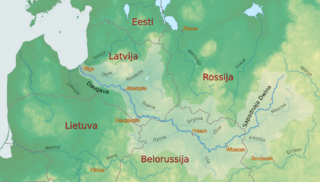
The Daugava or Western Dvina is a large river rising in the Valdai Hills of Russia that flows through Belarus and Latvia into the Gulf of Riga of the Baltic Sea. It rises close to the source of the Volga. It is 1,020 km (630 mi) in length, of which 352 km (219 mi) are in Latvia and 325 km (202 mi) are in Russia. It is a westward-flowing river, tracing out a great south-bending curve as it passes through northern Belarus.
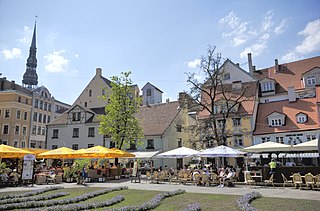
Riga is the capital and largest city of Latvia and is home to 605,802 inhabitants which is a third of Latvia's population. The city lies on the Gulf of Riga at the mouth of the Daugava river where it meets the Baltic Sea. Riga's territory covers 307.17 km2 (118.60 sq mi) and lies 1–10 m (3.3–32.8 ft) above sea level, on a flat and sandy plain.

Daugavpils is a state city in south-eastern Latvia, located on the banks of the Daugava River, from which the city gets its name. The parts of the city north of the river belong to the historical Latvian region of Latgale, and those to the south lie in Selonia. It is the second-largest city in the country after the capital Riga, which is located some 230 kilometres to its north-west.

Salaspils is a town in Latvia, the administrative centre of Salaspils Municipality. The town is situated on the northern bank of the Daugava river, 18 kilometers to the south-east of the city of Riga.

The Gauja River is a river in the Vidzeme region of Latvia. It is the only large river of Latvia that begins and ends its flow in Latvia. Its length is 460 km, of which 93.5 km are in the Gauja National Park. In this part, the Gauja River flows through the Gauja valley, which is 1 to 2.5 km wide, and the maximum depth near Sigulda is 85 m. Thus, Gauja is the longest river of Latvia when we count only the parts of the river in the country's territory. Daugava has only 367 km in Latvia, while the whole river is over 1000 km.
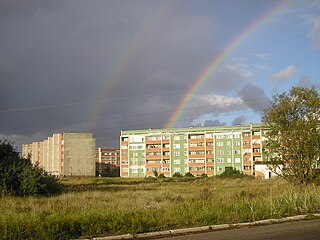
Bolderāja is a neighbourhood of Riga, the capital of Latvia. It is located on the left bank of the Daugava River, in Kurzeme District. Bolderāja probably began as a fishing village. The area has been inhabited since at least the 10th century and possibly for a longer period, however there is no firm evidence because of variations in the course of the Daugava River and the shifting of sand dunes.

Ikšķile is a town in Latvia, in Ogre Municipality. It was the first capital of the Roman Catholic Bishopric of Livonia, known by the German name of Üxküll. Saint Meinhard, known from the Livonian Chronicle of Henry, was the first bishop of Üxküll. In 1197 Berthold of Hanover, a Cistercian abbot of Loccum, was made the second bishop of Üxküll. Those days the town was the center of the upcoming crusading activities in the Livonian area. Bishop Berthold moved the episcopal see to Riga, but was killed by the Livs in battle.

Daugavpils District was an administrative division of Latvia, located in Latgale region, in the country's south-east. It was organized into two cities and twenty one parishes, each with a local government authority. The district council headquarters were located in the city of Daugavpils, which, however, was not part of the district. As of 2009, The district's area was 2,525.5 km2, which contained 21 parishes, one city and one municipality.

Vecrīga is the historical center and a neighbourhood of Riga, Latvia, located in the Central District on the east side of Daugava River. Vecrīga is famous for its old churches and cathedrals, such as Riga Cathedral and St. Peter's Church.

FK Daugava Rīga was a Latvian football club, based at the Daugava Stadium in Riga. They played in the Latvian Higher League. The last manager of the team was Armands Zeiberliņš.
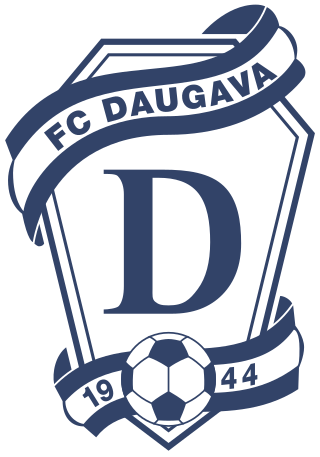
FC Daugava was a Latvian football club, based at the Daugava Stadium, in the city of Daugavpils. They lastly played in the Latvian Second League in 2015. They were one of two clubs with the name Daugava and should not be confused with FK Daugava Rīga.
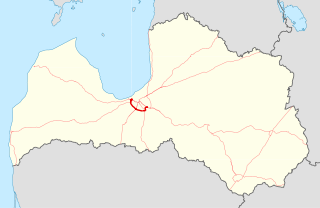
The A5 is a national road in Latvia which is part beltway around Riga, connecting Salaspils to Babīte. The road is also known as Riga bypass. The road is part of European route E67, European route E77 and Latvian TEN-T road network. The length of A5 is 41 kilometer. Currently A5 has 1x1 lanes until interchange with A9 then it turns to 2x2 all the way until Babīte. Most of the traffic on A5 is made up by trucks. A5 crosses river Daugava on Riga HES, and the A5 part on the HES has been reconstructed in 2010/2011. Another part of A5 between A8 and A9 was reconstructed in 2011. There are plans to build a new bridge over Daugava opposite to the end of A4, in further future. Current speed limit is 90 km/h. The average AADT of A5 in 2016 was 12 482 cars per day.

Garkalne Municipality was a municipality in Vidzeme, Latvia. The municipality was formed in 2007 by reorganization of Garkalne Parish. The seat of the council of the municipality is situated extraterritorially in Berģi, Riga. The population in 2020 was 8,923.

Mazā Jugla is a river in Latvia. It flows for 119 kilometres through the municipalities of Ogre, Salaspils, Ikšķile and Stopiņi. The source of the river is located in Taurupe parish, Ogre Municipality 130 m above sea level, whereas the mouth is 0.1 m asl.

Upeslejas is a village in Stopiņi Parish, Ropaži Municipality in the Vidzeme region of Latvia. It is located near Mazā Jugla river, about 15km from Riga.

Andrejs Kovaļovs is a Latvian footballer who most recently played for BFC Daugavpils and also represents the Latvia national football team.

Cinevilla is a backlot in Slampe parish in the Tukums Municipality in Latvia, and was created for the outdoor shootings of the feature film Defenders of Riga. It is the only backlot in Latvia, and consists of replicas of historical buildings and constructions of Riga, the capital of Latvia. The backlot has a small canal to resemble the Daugava river quays of the Riga old town. The Stone Bridge is also there as well as the historical Lübeck and Pontoon bridges.

The Battle of Jugla was a defensive battle of the Russian Republic's 12th Army of the First World War from 1 to 5 September 1917. It was part of the German offensive called the Battle of Riga or Schlacht um Riga. The main objective for the Russian 12th Army was to prevent the German 8th Army from forcing the Daugava river and besieging Russian troops in Riga.

Lucavsala is an island located on the Daugava River in Riga, Latvia. It has a population of 98.

Lielā Jugla is a river of Latvia. It flows for 63 kilometres, through the municipalities of Sigulda and Ropaži. The source of the river is located in Mālpils parish, Sigulda Municipality 71 m above sea level, whereas the mouth is 0.1 m asl. River slope is 1.1 m/km, annual drainage 0.26 km³. Lielā Jugla begins at the confluence of the Suda and Mergupe rivers in village Sidgunda.